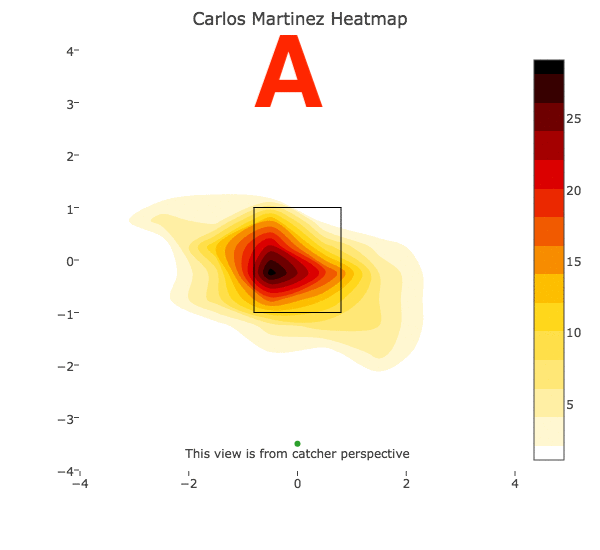Let’s pretend for the rest of this column that the lat injury Carlos Martinez returned from four starts ago isn’t an issue. I don’t know if it is. I don’t know if it isn’t. Creating a hypothesis on imperfect information is futile. I prefer to instead to try and understand if other tangible problems exist and whether they can be fixed. Martinez’s injury will be used as a natural timeframe to separate. Why? Because fantasy owners would be happy to take the early 2018 version of Martinez back.
The Cardinals ace has 20 walks and 18 strikeouts in his four starts since returning on June 5. Let’s nerd-out and take a look at how his approach to both handedness of hitter has changed.

A – pre injury (3/29 – 5/8); B – post injury (6/5 – 6/21)
Martinez appears to be using his four-seam fastball more to both left-handed (+17%) and right-handed hitters (+16%) at the expense of his other pitches, particularly his two-seam fastball. Over each of his last three seasons Martinez has decreased the usage on his four-seam fastball. His recent uptick could easily be a blip, but how the righty is using this pitch provides reason to think it’s a conscious decision. Martinez is still slider-dominant when he is ahead against hitters, but across the board we’re observing upticks in four-seamer usage at the expense of nearly all of his other pitches (particularly his two-seamer).
The reasoning against this four-seamer to two-seamer change is that Martinez might really be struggling with command of his pitches. This could be pushing him to his four-seamer more in all counts as an attempt to “establish” the pitch in-game. Supporting this theory is his grotesque walk rate and shorted outings with severe lack of control.
What seems to be an unintended consequence of this four-seamer usage change is where the majority of Martinez’s pitches are landing in the zone. Below is a heatmap showing, first (A), Martinez’s two-seam fastball usage pre-injury. Following it (B) is his four-seam fastball usage from his post-injury sample. My reasoning for comparing two different pitches is that each, in their respective time windows, is Martinez’s dominant pitch (thrown ~30 percent of the time).

Martinez’s main concentration of pitches is now up in the zone, as opposed to sitting in the bottom to inner-third of the plate to right-handed hitters. The two-seamer which he has faded usage on is being elevated as well. In this two-seamer’s elevation lies the greatest concern. BrooksBaseball has Martinez’s two-seamer sitting with a .636 batting average against and a .727 slugging against. BABIP luck and small-sample bias are embedded within both stats, but even accounting for both those points, Martinez’s two-seamer has become an liability. It’s up in the zone and it’s getting hit around.
His four-seam fastball elevation, however, doesn’t immediately signal concern. Elevation of a four-seam fastball in combination with a good two-seamer is a common strategy. Given that Martinez’s two-seamer is lacking the “good” descriptor shows he might be relying on his four-seamer more, likely understanding that his two-seam location isn’t where it was early in the season.
To make Martinez’s struggles even more confusing, the pitch surviving this madness is his changeup. Generally a “feel” pitch for most pitchers, Martinez has found a way to lose feel on other pitches that aren’t the one I expected to see substantial deviation from the norm. His location has remained essentially unchanged, it’s been one of the few stable pitches in his repertoire, and he’s using the pitch less than usual. My guess on Martinez’s main issue was going to be a mechanical nuance some video watching hasn’t allowed me to uncover, but his ability to locate his changeup, a pitch that should mimic the arm speed of his fastballs, leaves me struggling for a proposed correction.
With pitchers who have accumulated enough innings to provide a sample of innings that projections can confidently work their magic on, I always feel like there is less volatility given you can set your expectations with slightly more accuracy. Young arms with no sample and only minor league data make for volatile creatures. Martinez is able to blend both of these characteristics in a manner so confounding that it’s tough to resist and tough to tolerate.
The Razzball Player Rater is has Martinez as a top-30 starting pitcher, inside our top-150 overall for standard roto leagues. Projections expect correction in the form of a sharp cut in WHIP, reversion to a slightly below average ERA, and strikeout numbers that call back to the days of old. Let’s keep an eye on the location of his sinker moving forward. After that – hopefully – happens, we should see a flip back to dominating two-seamer usage and stable elevation of his four-seamer to compliment his repertoire. We can only hope by then his changeup and slider don’t become the issue.
If they do, it might just be part of the experience.


